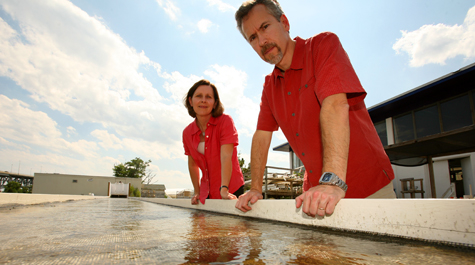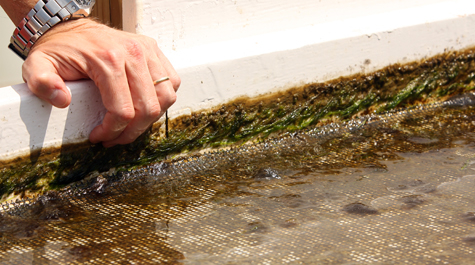Fuel from Algae
It might seem almost too good to be true, but research at VIMS may turn our nation’s energy issues inside out, using wild algae to convert what is now a troublesome pollutant into a fuel that can help power our cars.
The research, by VIMS professors Emmett Duffy and Elizabeth Canuel, is part of the collaborative, multi-institutional Chesapeake Algae Project (ChAP). In addition to Duffy, Canuel, and their graduate students and technicians, ChAP involves faculty and undergrads in the Biology, Chemistry, and Physics departments at William and Mary, and researchers at the Smithsonian Institution, the University of Maryland, the University of Arkansas, and Western Michigan University. Industry partners are Statoil, Blackrock Energy, and HydroMentia.
Duffy says that the project’s goal is to “close the loop” between waste production and energy use. He notes that society’s current energy model is both unsustainable and polluting—we depend on a finite pool of fossil fuels to power our machines and fertilize our crops, and suffer when byproducts like excess carbon dioxide and nitrogen enter our air and water.
The ChAP model aims to reverse this equation. Wild algae can take up the excess nitrogen that plagues Chesapeake Bay and other coastal waters, using it to form cells that in certain species contain almost 50% lipids—oily organic compounds that can be used to make biodiesel and other transportation fuels. As an added bonus, the non-lipid components of the cell promise use as an organic fertilizer, thus capturing nutrient runoff that produces dead zones in coastal waters and placing the nutrients back where they belong—in farm soils.
The model is also elegant in its simplicity—relying on naturally occurring strains of wild algae rather than the high-tech, genetically modified strains being tested in many other labs. “That allows us to take advantage of the lessons learned by algae during their 3 billion years of evolution,” says Duffy.
The focus of Duffy and Canuel’s research—in a land-based flow way at VIMS as well as culture units in the estuary—is to measure the oil content of various wild algal strains, and to determine how algal growth rates, oil production, and pollutant scrubbing vary with temperature, salinity, light levels, and other environmental factors.
Colleagues are conducting similar experiments in floating harvesters on Lake Matoaka on the William and Mary campus in Williamsburg, and in the York River alongside VIMS’ Gloucester Point campus. The harvesters also allow for engineering tests to establish design criteria for use in the rigorous real-world conditions of the Bay.
These experiments are all part of an overall effort to better understand how the ChAP concept might scale up to the levels needed to make an appreciable dent in our nation’s 20-million-barrel per day oil habit.


